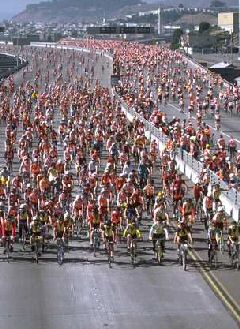Home Page
The latest articles, features and news.


Read About...


|
| | |
|
29 August 2005
Erectile Problems And Cycling Under The Spotlight
by George Atkinson  Most men would expect a little exercise to be beneficial, but it turns out that cycling can actually be detrimental to male sexual function. A study, published in 2002, implicated bicycle riding with an increased risk of erectile dysfunction. Conducted by sexual and reproductive health researcher Steven Schrader, the study looked at the hazards of bicycle riding in police officers. The study found that night-time erections were of a poorer quality in biking police officers compared to non-biking police officers. Additionally, the night-time erection quality decreased as seat pressure increased, and also as the average number of hours in the saddle a day increased.
Most men would expect a little exercise to be beneficial, but it turns out that cycling can actually be detrimental to male sexual function. A study, published in 2002, implicated bicycle riding with an increased risk of erectile dysfunction. Conducted by sexual and reproductive health researcher Steven Schrader, the study looked at the hazards of bicycle riding in police officers. The study found that night-time erections were of a poorer quality in biking police officers compared to non-biking police officers. Additionally, the night-time erection quality decreased as seat pressure increased, and also as the average number of hours in the saddle a day increased. It seems that Schrader may have inadvertently triggered something of an avalanche of research into the topic of male sexual health and cycling. The latest issue of The Journal of Sexual Medicine contains three studies looking at how bike riding can affect the male reproductive system. Schrader himself was asked to review the three new articles - Bicycle Riding and Erectile Dysfunction, Study of the Perineum - Saddle Interface in Men with Erectile Dysfunction and Development of a New Geometric Bicycle Saddle for the Maintenance of Genital-Perineal Vascular Perfusion. The three articles look into the mechanics of erectile dysfunction brought on by bicycling. They together report that the high pressures in the perineum (the area between the scrotum and the anus) while straddling a saddle compress and temporarily stifle penile blood flow. The researchers also hypothesized that the lining vessels of the compressed arteries become damaged, thus leading to the possibility of permanent artery blockage. But not all men who ride bicycles will develop erectile dysfunction. One past study suggested that sexual health consequences adversely affect 5 percent of riders. "One would not expect that every bicyclist would suffer from erectile dysfunction any more than one would expect every smoker would get lung cancer," said Schrader. While the evidence linking erectile dysfunction and cycling keeps mounting, Schrader believes it's time for some solutions. Whereas past research emphasized whether or not a relationship existed between bicycle riding on a saddle and erectile dysfunction, Schrader now says that the next step of contemporary research on the subject should focus on intervention. And if that happens, it's possible that we may see some radically redesigned bicycle seats hitting the market in the near future. "The next steps are quite clear. Effective strategies based on sound ergonometrics and urogenital physiologic principles and testing are needed to reduce the risk of erectile dysfunction from bicycle riding," he said in conclusion.
|
|

